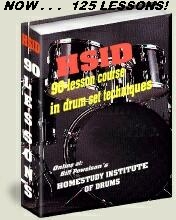This is for those of you who are having trouble will rolls and fills. It is guaranteed to take the embarrassing kinks out of your playing style. Learn to connect will fills every time in mid-song! Contains beginner and advanced material.
This lesson has been written to appeal to everyone on the newsletter mailing list. You will go from beginner to advanced, all in one lesson. Don't let the complexities in 'Rudiments, Rolls & Fills PART II' discourage you. It may take some time to comprehend it all.
Also, it is important that you know how to manipulate the hi-hat as described in this first half of this lesson . . . before learning to do the fills. I don't know for sure if you are using the hi-hat in this way, so I am including it as a part of the lesson.
BEGINNERS CORNER
======================
SPECIAL NOTES:
#1. In the lesson that follows, I am assuming you have mastered 'The Basic Dance Beats' lesson.
#2. I realize that many of you do not own a drum set. No problem! You can practice these routines right where you are. Use your imagination! Tap on anything nearby and pat your feet on the floor. Get accustomed to practicing this way. I recommend it for EVERYONE, including those who DO own a drumset. Doing so will allow you to practice anywhere you may be. Get into the habit of mastering all the necessary, boring routines while away from the kit. Then, when you finally do get a few minutes on the set . . . you'll have a ball, playing all the new ideas as you jam.
There are many approaches to using the hi-hat but the most common technique is to kick the hi-hat on the 'back beat' of the particular dance beat you may be playing. The 'backbeat' is the snare portion of the basic dance beat. If you are playing 8th note rock as it is shown below, your right hand will be on the RIDE cymbal (not the hi-hat) and you will kick the hi-hat with your left foot as you connect with the third cymbal note and simultaneous snare. ( Left-handed students must do their own transposing here.)
8TH NOTE ROCK:

 It is hard to hear the hi-hat on the backbeat (snare) but it is there!
It is hard to hear the hi-hat on the backbeat (snare) but it is there!
Get accustomed to kicking the hi-hat with each repetition of the above pattern as you jam with your favorite recordings. It will become second nature with only a little practice. Try doing the same thing with *ALL* the basic dance beats. You *DO* have all the basic dance beats memorized! Right?
NOTE:
The Waltz beat is an exception. Many drummers kick the hi-hat on 2 & 3 of most Waltz beat patterns.
INTERMEDIATE CORNER
======================
MAGIC FORMULA FOR SIMPLE FILLS:
One of the most common E-mail questions I receive at the website, concerns fills (i.e. dropping rolls into a song while jamming). Everyone seems to be looking for a 'magic formula' to help them develop their roll patterns.
I learned by listening to various drummers and imitating their rhythmic ideas. I recommend this to everyone, but there are other things we can do to make the learning process a little easier.
NOTE:
The following trick will work with nearly any dance beat pattern, but for simplicity, we will use the 8th note rock beat to illustrate the idea.If you have not learned to play the 8th note rock beat yet, go GO HERE.
In this exercise, you will learn to jump from a basic dance beat, then improvise (or make up) a random fill and return to the beat. It is easier than you think, if you are comfortable using the hi-hat as it was studied in the 'Beginners Corner' above.
LET'S DO IT!
Play a repetitious, basic 8th note rock beat and kick the hi-hat as we learned earlier (above). Get it going! Keep it going for awhile, then stop hitting the ride cymbal and snare.
That's right! STOP YOUR HANDS, but continue with both feet. Hold both arms over the drums, but don't hit anything yet. Your feet will be playing the steady beat, producing a "boom, chic, boom, chic" effect.
Keep the feet going in steady rhythm, just as they were when the hands were engaged. If you were playing along with a song, the feet would remain 'in time' with the music. Got it?
OK! You are half way home! The feet are still marking time . . . boom, chic, boom, chic . . .
Begin thrashing at the drums with both hands! Do anything you want but don't lose the flow of the bass and hi-hat. The . . . boom, chic, boom, chic . . . effect should remain steady as you thrash about with the hands. Bang away on the snare, go to the toms and back. In short, do anything that sounds good to your ear. Challenge yourself to do this for long periods of time as the feet maintain the steady rhythm. It gets easier with a little practice!
You are now playing an improvised fill!!! That is all there is to it! The hard part will be in returning to the beat, without losing tempo.
RETURNING TO THE BEAT . . .
Ok! You are still thrashing away at the drums with both hands while the feet are marking time . . .
Resume playing the beat on *ANY* bass drum (or right foot)! Your right foot has not stopped (we hope). Each right foot marks the beginning of another repetition of the beat . . . so, just come in playing the (8th note rock) beat on *ANY* boom sound or right foot.
(LEFTIES: You must do your own transposing here.)
REMEMBER THESE THOUGHTS:
You can do anything you wish as a fill . . . and the fill may be of any length you desire. You may play on any of the drums (objects) in front of you. Just maintain the beat flow with your feet as you play your fill. This way, you will never lose track of the beat flow within the music.
Practice the above lesson without music until it becomes 'natural' or 'second nature'. Then try it with simple, medium tempo songs. You needn't wait for the drummer on the recording to play a fill either. You may add your fills anywhere you choose for now, while you are learning.
LISTEN TO THESE EXAMPLES:
EXAMPLE A: You may memorize these examples if you like but the real point being made is that you can do ANYTHING as a fill . . . just don't lose the beat flow.
You may memorize these examples if you like but the real point being made is that you can do ANYTHING as a fill . . . just don't lose the beat flow.
EXAMPLE B: Here is another!
Here is another!
Later on, you will learn to be selective about fill placements. Fills are normally used by drummers to 'fill' up the holes or dead spots in a song. We usually save our fills for those little empty gaps in the music where nothing much is going on (i.e. between verses or leading into the chorus of a song.)
My very best-kept, MOST VALUABLE secrets, ARE HERE!
Finite To Infinity
3 very important questions
IS IT POSSIBLE THAT YOUR 'NATURAL GIFT' OF RHYTHM CAN BE DOUBLED WITH ONLY A LITTLE ADDITIONAL (PREVIOUSLY UNAVAILABLE), KNOWLEDGE?
IS THERE A 'KNOWLEDGE GAP' IN YOUR OWN UNDERSTANDING OF 'RHYTHM'?
IS IT POSSIBLE TO GAIN A COMPLETE AND THOROUGH UNDERSTANDING OF 'ALL RHYTHM', WITHIN ONLY A COUPLE HOURS OF EASY, AND FASCINATING, STUDY ?
Answers: YES! YES! YES!
Get All Products Here

GET ALL THE PRODUCTS AT ONE LOW PRICE.
SURPRISES ABOUND!!!! . . . For those with a bit of generosity in their soul.
CLICK HERE , to see what I mean.
Intermediate & Advanced Drummers
- Drum Instructors Wanted
- Teach My Lessons and Methods
- Up to $60.00/hour
Pre-School Drummer?
Can we teach rhythm to pre-schoolers? YES!
This is a very short course, designed to help adults plant the seeds of rhythm into children of nearly any age. Click Here!!
Make CASH $$$ Now!!!

FREE ELECTRONIC BOOK BONUS (also included) BUSINESS OPPORTUNITY:
- * MAKE BIG MONEY SELLING USED DRUMSETS!
- * INSIDER HARDBALL-BUYING-TIPS AND SECRETS.
- * UNIQUE RECOVERING SECRETS
Support Us Today!!
Support this site and and gain an advetising bargain with the deal. Place a permanent ad here.

